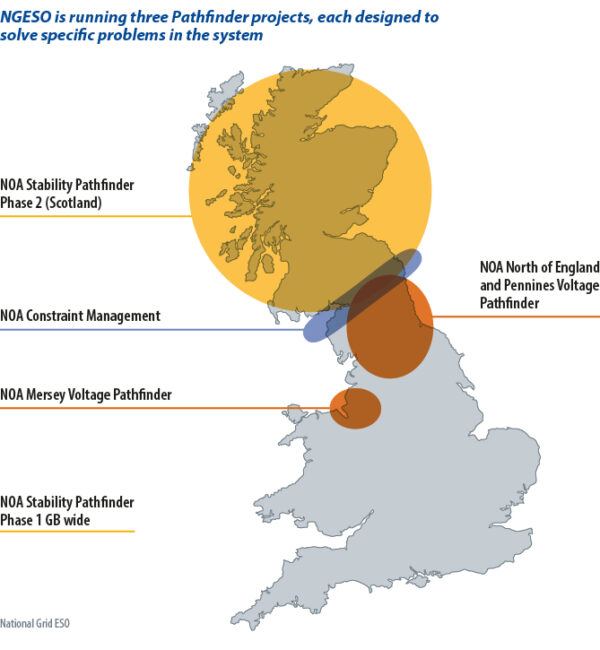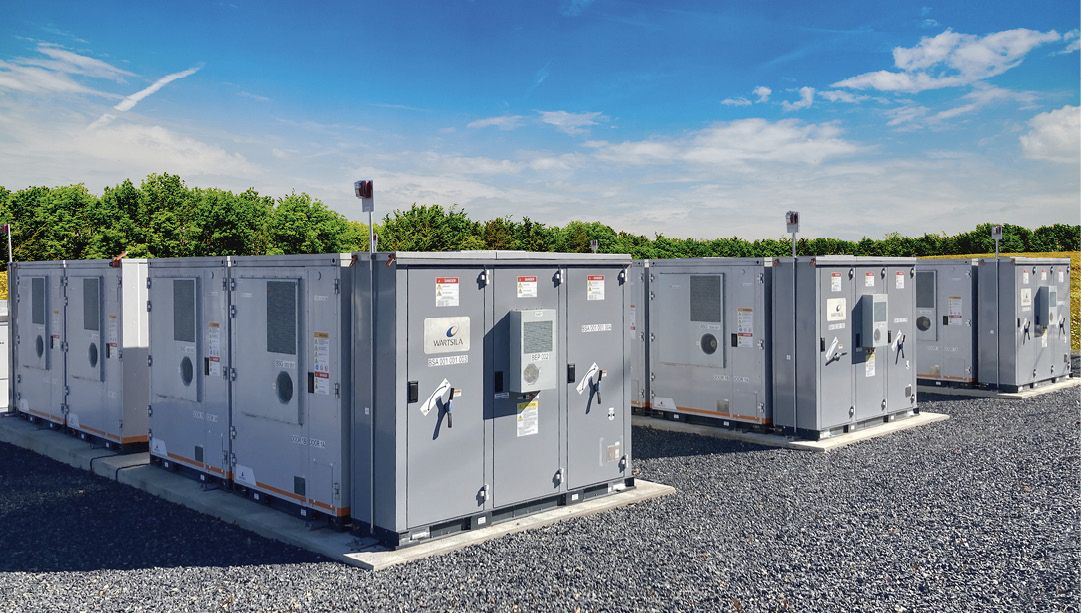In February 2023, construction began on 200 MW of a 300 MW/600 MWh battery energy storage system (BESS) site in Blackhillock, Scotland. Developers want it to be the world’s first transmission-connected BESS to offer grid stability. Rather than boost or replace wires, Blackhillock will provide full active and reactive power services.
With the UK aiming for zero-carbon power by 2025, as part of its 2050 net-zero-economy goal, utility National Grid ESO (NGESO) buys grid-stability services from private assets including Blackhillock. While phase 1 of NGESO’s Stability Pathfinder project included only synchronous condensers, phase 2 admitted grid forming inverter assets to the tender.
Four companies secured 10 contracts under the tender last April, to address insufficient short-circuit levels (SCL) – the amount of current flowing during faults – across Scotland. The winning bidders will also offer “green” inertia to balance supply and demand after events such as trips at power stations, which change system frequency. Five synchronous condensers and five battery sites secured GBP 323 million ($395 million) worth of contracts.
“We believe this is the first time in the world where grid forming inverters have been used in multiple locations across a region to provide a system-wide solution to short circuit level and inertia,” said National Grid Head of Networks Julian Leslie. “These zero-carbon, stability-improving devices will enable more green electricity to run, are cheaper for consumers, and will allow the market to deliver as much wind generation as possible.”
Revenue stacking
Three of the battery contracts, including Blackhillock, were won by UK-based Zenobe. The company will also develop the 300 MW/600 MWh Kilmarnock South site due in 2025 and a 400MW/800 MWh Eccles facility the following year. The gigawatt of batteries should provide 4.4 GVAs (gigavolt ampere seconds) of inertia – 5% to 10% of Britain’s requirement.
“The reason why we were so competitive is that we were able to stack the revenues that we would generate from day-ahead and intraday markets, frequency response services, reactive power, balancing mechanism, and other services in combination with stability services,” says Semih Oztreves, director of network infrastructure at Zenobe. “When you stack these services up, you can provide stability services almost at one tenth of what it would cost to provide it exclusively. Stability services are an additional revenue stack without a lot of additional capex (capital expenditure) and opex (operating expenditure). It’s about utilizing your BESS to the maximum.”
In Europe, EU law prohibits storage-as-transmission projects from trading electricity in energy or balancing markets as the batteries are owned by electricity transmission system operators and deemed “fully integrated network components.” Grid booster batteries spend most of the time on standby for grid congestion relief. Regulators are debating whether SAT assets should be permitted to offer additional services.
“Stacking up revenues for SAT projects depends on their use case,” says Lars Stephan, senior policy and market development manager for Europe, the Middle East, and Africa at German and US-owned energy storage heavyweight Fluence. “In Germany, we see that Netzbooster [grid booster] SAT projects can create significant economic benefits by increasing the utilization of existing transmission lines and by being executed much faster than the construction of new traditional transmission lines. They don’t need additional revenues but are executed based on the SAT case alone.”
Spanish grid company Red Electrica will tender a SAT project to raise use of interconnectors from the mainland to the Balearic Islands. “This use case also does not require additional revenue streams and it could also be interesting for the UK,” adds Stephan.
Fluence is delivering SAT projects in Germany, Lithuania, and Australia. While BESS costs make it impossible to compete with conventional inertia, SCL, and reactive power providers in isolation, such assets are multifunctional. At Zenobe, for instance, stability contracts account for only 10% of battery site revenue.
National Grid’s Stability Pathfinder 2 tender offered to pay up to €6,500 ($6,985) per megavolt ampere of short circuit power per year with the successful bids averaging around €4,000/MVA. It is difficult to estimate which of the non-frequency ancillary services offered by SAT assets has the most potential.
“The value of various services will change over time,” says Fluence’s Stephan. “Currently, synthetic inertia and short-circuit contribution, procured under Stability Pathfinder 2, create strong revenue potential besides the already existing reactive power contracts for battery-based energy storage. It is important to be able to stack them dynamically and have a system that can enable this.”
Stacking services, however, is not straightforward. “To deliver all these services together, you need a very complicated control system that many in the industry are not able or not willing to engineer,” says Zenobe’s Oztreves. “We have demonstrated, through feasibility studies, that we can do it and now we are building these assets effectively.”
 Blackhillock is due in mid-2024 and Gabriele Buccini – senior manager for storage business development at battery project partner Wärtsilä – says, “Although the system will deliver a new type of service, the engineering and software testing that is required for this project will take place in parallel to the procurement of equipment. So, from that perspective, it doesn’t add any new level of complexity.” Additional testing will be performed regarding the provision of short and power-intensive services.
Blackhillock is due in mid-2024 and Gabriele Buccini – senior manager for storage business development at battery project partner Wärtsilä – says, “Although the system will deliver a new type of service, the engineering and software testing that is required for this project will take place in parallel to the procurement of equipment. So, from that perspective, it doesn’t add any new level of complexity.” Additional testing will be performed regarding the provision of short and power-intensive services.
Winning trust
Inertia, typically a by-product of thermal power stations, requires a five-millisecond response to prevent brown- or blackouts. Grid-forming inverter batteries need to change response profile every five milliseconds while bidding into other markets; providing active, and absorbing reactive, power; and offering fault ride-through. Demonstrating such capability to National Grid took Zenobe and inverter partner SMA almost a year.
“We started discussion with National Grid ESO more than two years ago on the Stability Pathfinder program,” says SMA Business Development Manager Aaron Gerdemann. “It soon became clear that this is the first tender of its kind in the world to procure stability services from inverter-based resources.” Gerdemann says SMA has since secured several UK storage-as-transmission projects, all linked to Pathfinder 2. “Our solution allows project owners to stack services to improve their business case and provide much more flexible and competitive services than traditional solutions,” he adds.
Proof took the form of hundreds of pages of feasibility studies showing the battery could deliver grid stability under any circumstances from a specific connection point, per grid code requirements. Bidders were asked to state how much short circuit levels and inertia they could provide. “Based on that, we were able to optimize our bid strategy with the technical capabilities of the equipment that we would install, and work out what is stackable, what is not stackable,” says Zenobe’s Oztreves. “The availability requirements for the SAT assets are high. However, NGESO set a more-than 90% availability requirement which again allowed us to provide these services very competitively. In some other countries, the SAT assets are faced with extreme availability requirements of 99.95%, which adds a huge amount of cost to these solutions.” National Grid was able to be more flexible as it has procured the services from a dozen generators.
The utility is feeling its way. In November 2022, NGESO Customer Connections Senior Manager Susana Neves e Brooks said, “The current approach takes a more conservative view of what the assumed behaviors of storage could be, instead of how they may now respond to the needs of the energy market.” The company, she added, is “focused on leading the way to identify the best approach that enables the connection of storage projects.”
This content is protected by copyright and may not be reused. If you want to cooperate with us and would like to reuse some of our content, please contact: editors@pv-magazine.com.




1 comment
By submitting this form you agree to pv magazine using your data for the purposes of publishing your comment.
Your personal data will only be disclosed or otherwise transmitted to third parties for the purposes of spam filtering or if this is necessary for technical maintenance of the website. Any other transfer to third parties will not take place unless this is justified on the basis of applicable data protection regulations or if pv magazine is legally obliged to do so.
You may revoke this consent at any time with effect for the future, in which case your personal data will be deleted immediately. Otherwise, your data will be deleted if pv magazine has processed your request or the purpose of data storage is fulfilled.
Further information on data privacy can be found in our Data Protection Policy.